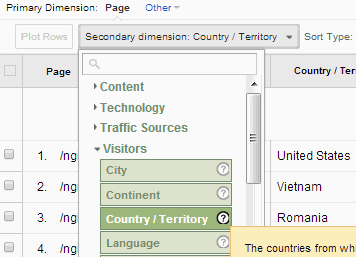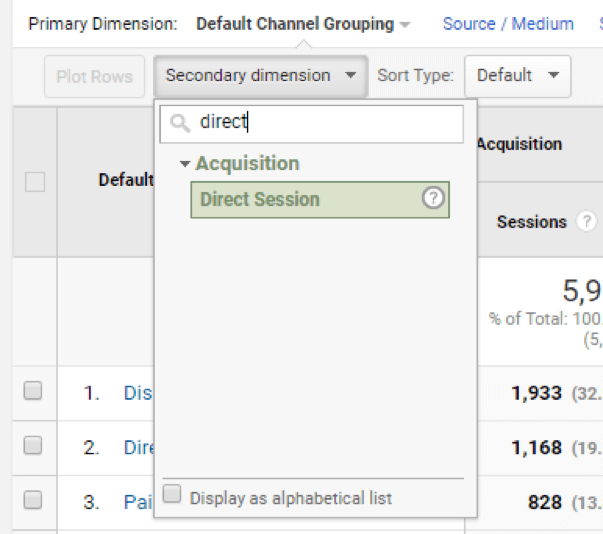Step-by-Step Overview: Leveraging Secondary Dimension in Google Analytics
Step-by-Step Overview: Leveraging Secondary Dimension in Google Analytics
Blog Article
Optimize Coverage Precision With Additional Measurement in Google Analytics
Understanding how to take full advantage of reporting precision with additional dimensions in Google Analytics can considerably boost the deepness of insights acquired from information evaluation. By incorporating secondary measurements tactically, marketing professionals can uncover concealed patterns and relationships that might not be promptly noticeable when analyzing primary metrics alone. This nuanced technique makes it possible for a much more comprehensive understanding of customer habits and project efficiency, leading the way for more targeted and effective decision-making. The application of additional measurements holds the vital to opening a wide range of beneficial information that can transform the effectiveness of electronic marketing strategies.
Comprehending Additional Measurements in Google Analytics
To improve data evaluation and gain deeper understandings into user behavior, understanding additional dimensions in Google Analytics is necessary. Second measurements enable individuals to section and additionally study information past the key measurement selected. By integrating secondary measurements, experts can fine-tune their records to reveal more detailed info about user interactions on an internet site. For instance, while the main dimension may display the total variety of web page sights, adding a second measurement such as 'source/medium' can supply insights into where the web traffic stemmed from. This additional layer of details makes it possible for marketing experts to examine the efficiency of various marketing campaigns or channels in driving traffic to the website.
Furthermore, recognizing secondary dimensions is crucial for creating extra customized records customized to certain company objectives. By selecting the ideal combination of primary and second measurements, experts can uncover patterns, fads, and correlations that might otherwise stay concealed. This nuanced approach to information analysis encourages companies to make enlightened decisions based on a thorough understanding of user actions throughout various dimensions.

Exactly How to Apply Secondary Dimensions
When leveraging second measurements in Google Analytics, the sensible application entails selecting details data parameters to additional refine understandings past the primary measurement's scope. To apply second dimensions effectively, begin by accessing the report or dataset where you want to delve deeper right into the information. Remember that second dimensions help provide context and granularity to your key dimension information, enabling you to remove more significant and actionable understandings from your Google Analytics records.
Leveraging Additional Dimensions for Insights
Utilizing additional measurements in Google Analytics permits an extra thorough analysis of data, providing beneficial understandings past the key dimension's extent. By leveraging second dimensions, customers can dive much deeper right into the performance metrics of their website or application, discovering concealed patterns and patterns that may not be right away obvious when just checking out key measurements.
One trick advantage of using secondary dimensions is the ability to section and filter data more precisely. This can aid analysts and online marketers better understand the actions of specific individual segments, such as brand-new site visitors versus returning site visitors, or traffic originating from different geographic areas.
Furthermore, secondary measurements enable customers to compare and comparison different information factors within the same record, offering a much more alternative view of performance (Secondary Dimension in Google Analytics). Coupling the key measurement of landing pages with second measurements like demographics or tools can reveal which web pages are most effective in involving individuals on various devices or from various market groups.
In essence, leveraging secondary dimensions in Google Analytics encourages users to extract richer insights from their information, causing more enlightened decision-making and eventually, enhanced efficiency.
Ideal Practices for Second Dimensions
When examining information in Google Analytics, incorporating second dimensions efficiently improves the depth of insights obtained from the main metrics. Choosing appropriate second dimensions aids in giving context and a more clear understanding of the data being analyzed.
In addition, it is suggested to limit the number of secondary dimensions made use of in try here a single report to prevent overwhelming the analysis with excessive details. Concentrating on a few key additional dimensions at a time can cause even more focused and actionable understandings. In addition, consider trying out various combinations of second and primary measurements to uncover special patterns and patterns that may not be evident when taking a look at the information in seclusion.
Advanced Evaluation Strategies With Second Measurements
Discovering elaborate data connections through the strategic application of additional dimensions can reveal nuanced understandings that elevate the depth of evaluation in Google Analytics. By combining second dimensions with primary data collections, innovative evaluation strategies can be employed to draw out beneficial info. One such technique is accomplice analysis, where second dimensions enable the division of individuals into groups sharing common characteristics. This method enables a much deeper understanding of individual actions patterns with time, assisting in the recognition of fads and the analysis see this website of marketing campaigns' performance.
Additionally, additional dimensions can boost the evaluation of conversion paths by providing additional context. Understanding the various touchpoints an individual connects with prior to transforming can be vital in enhancing the client journey - Secondary Dimension in Google Analytics. By using second dimensions to explore specifics such as web traffic resources or devices made use of, marketers can tailor approaches to target high-converting channels properly
Conclusion

To improve information analysis and gain much deeper insights right into individual actions, comprehending second dimensions in Google Analytics is vital - Secondary Dimension in Google Analytics. Second dimensions permit customers to section and better study data past the primary measurement selected. While the main measurement may show the total number of web page views, adding a second dimension such as 'source/medium' can supply understandings into where the website traffic stemmed from.When leveraging second dimensions in Google Analytics, the sensible application involves choosing details data specifications to more improve insights beyond the main measurement's scope. Keep in see this website mind that secondary dimensions help offer context and granularity to your main measurement data, enabling you to draw out even more significant and workable insights from your Google Analytics reports
Report this page